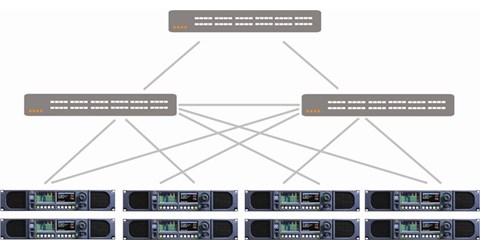EXPLORE THE HUB: Hot Topcis and Deep Dives | Ebooks and Technical Application | Case Studies
ISSUE 2: WHEN DOES IP MAKE SENSE?

UNDERSTANDING THE NEEDS FOR AND THE BENEFITS OF AN IP INFRASTRUCTURES
- IP infrastructures help ease 4K/UHD production
- IP infrastructures provide graceful scaling not possible with SDI.
- Grow your infrastructure by adding leaf and spine switches as and when your business requires.
Premium 4K/UHD Services
A number of streaming services now charge a monthly premium when their service includes 4K/UHD content, while many pay per view (PPV) services charge a premium to deliver individual movies and sporting events. In both cases, if creating or delivering content in 4K/UHD is part of the business model, IP infrastructure is what makes execution practical.
Ever Larger Scale Routing
As major live productions and internal routing at major broadcast centers add more channels to accommodate the growing number of audience delivery options, system designers are reaching a point where IP infrastructure simply makes practical economic sense. Some systems are so large it is difficult to even buy an SDI router at a reasonable price. But in the long term, it is the lack of flexibility of SDI routing that is problematic. If the number of channels continues to grow after a new SDI router is installed, what then? When very large systems cannot grow or change quickly, business opportunities are lost.
Meeting The OTT Competition
In 2014, OTT service providers started making a notable business impact on US traditional broadcast viewership. In the same year that Netflix achieved 50 million US subscribers and other OTT providers continued to grow theirs, the Nielsen rating service started reporting a slow but steady decline among almost all US linear TV viewers. When TV executives took a serious look at the trend, they realized that OTT delivery needed to be a part of their delivery options. IP technology is what makes this possible.
THE BASIC ADVANTAGES IP INFRASTRUCTURE CAN GIVE AN ORGANIZATION:
Scalability
The most basic advantage of IP is that you can ramp up and down the size of a television workflow or digital distribution network very quickly. Let’s say you are a broadcaster at the Olympics and want to add 50 digital channels for a month, and after the event take them away. With commercial SDI infrastructure, you would have to forklift in a huge dedicated temporary router and buy all the connecting hardware components, probably for a one-time use. Using IP technology you can extend your existing routing and control infrastructure, built on an expandable leaf and spine technology, simply by adding a few extra leafs.
Leaf and spine architecture is like having a classic SDI router cross point card that has been made elastic. You can stretch it out and expand it without having to replace your router. You can also add extra capacity and remove it. The same expansion in SDI would mean either replacing your router with a larger one or introducing additional routers around the main router through tielines. As new opportunities emerge, IP infrastructure enables a faster reaction time to take advantage of them. For example, if a new on-demand audience is identified, a new advertising market emerges, or a compelling programming idea is created, IP enables an organization to launch a new channel or reformat the workflow of an existing one to take advantage quickly.
New Standards, No Problem
Since the time broadcasters went from black and white to color, every time a new production format standard was introduced, broadcasters had to completely rebuild facilities. With IP, upgrading to the next video standard no longer means a system rebuild, it could just be a software tweak. With SDI, when a new production standard came along we had to rebuild infrastructure. Take out an HD router and put in a 3-gig router or take out the 3 GB/S router and put in a 4K one. Thanks to IP, those days are behind us because IP is format agnostic. However, just because we now have 4K it doesn’t mean there won’t be new standards arriving to improve image and audio quality that will require facility upgrades. We will never be done with format and standard changes. On the horizon is high dynamic range (HDR), high frame rate, and even 8K and VR. But once you have your video in all those IP packets, it does not matter if the format is 4K or 8K, the fundamental architecture remains unchanged.
Less Costly Program Testing
The ability to add or remove production workflows and digital distribution at will gives the opportunity to test new programming ideas without building physical infrastructure. If someone wanted to dip their toe in the water and test a 4K sports channel, they could add a 4K channel as a leaf on the edge of their system while they did the experiments. If the experiments proved their 4K channel could become mainstream, it would be easy to migrate extra blocks of the system to define the whole system as 4K. The ease of re-configuring workflow and distribution could usher in a renaissance of television programming experimentation. Now, consider this: combining a better understanding of viewer preference via IP distribution, with the ability to test new programming without building dedicated infrastructure, can give a competitive advantage in creating hit TV programming.
Read Issue Three Here > ST 2022-6 vs ST-2110


